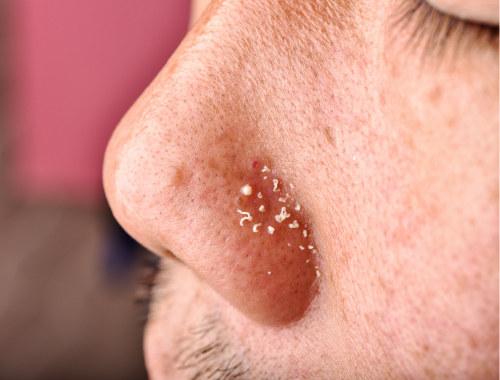Difference Between Pustules and Whiteheads
Pustules are pus-filled fluid collections that are one cm in diameter. Whiteheads are oil and dead skin-filled closed bumps on the skin.

What are Pustules?
Definition:
Pustules are pus-filled fluid collections that are one cm in diameter.
Causes:
Pustules may form secondary to infections. These can occur as an allergic reaction to food or allergens. Cystic acne also causes pustule eruption.
Appearance:
Pustules appear as tender red bumps on the skin with a white fluid-filled center. These are common on the face, chest, trunk, and hairline.
Diagnosis:
Pustules are diagnosed easily on physical examination.
Treatment:
Over-the-counter acne medications, creams, and lotions are used to treat small pustules. Pustules that are long-lasting need to be treated by a dermatologist. The doctor might prescribe oral antibiotics like doxycycline, or topical creams containing dapsone or salicylic acid. In severe cases, photodynamic therapy might be needed to get rid of pustules.

What are Whiteheads?
Definition:
Whiteheads are oil and dead skin-filled closed bumps on the skin.
Causes:
Inflammation of sebaceous glands and hair follicles leads to the formation of whiteheads on the skin. This occurs due to increased sebum production and increased bacterial growth on skin.
Appearance:
Whiteheads are mostly asymptomatic. They are characterized as small white or yellow bumps on the skin. Sometimes whiteheads may be slightly tender.
Diagnosis:
Whiteheads are easily diagnosed by appearance. Severe acne with whiteheads and blackheads needs to be assessed thoroughly by a dermatologist.
Treatment:
Nonprescription medicines against whiteheads include serums and lotions containing salicylic acid, azelaic acid, benzyl peroxide, and retinoids. Prescribed medicines against whiteheads include antibiotics, strong retinoids, dermabrasion, and laser skin surfacing.
Difference between Pustules and Whiteheads
Definition:
Pustules are pus-filled fluid collections that are one cm in diameter. Whiteheads are oil and dead skin-filled closed bumps on the skin.
Causes:
Pustules may form secondary to infections. These can occur as an allergic reaction to food or allergens. Cystic acne also causes pustule eruption. Inflammation of sebaceous glands and hair follicles leads to the formation of whiteheads on the skin. This occurs due to increased sebum production and increased bacterial growth on skin.
Appearance:
Pustules appear as tender red bumps on the skin with a white fluid-filled center. These are common on the face, chest, trunk, and hairline.
Whiteheads are mostly asymptomatic. They are characterized as small white or yellow bumps on the skin. Sometimes whiteheads may be slightly tender.
Diagnosis:
Pustules are diagnosed easily on physical examination. Whiteheads are easily diagnosed by appearance. Severe acne with whiteheads and blackheads needs to be assessed thoroughly by a dermatologist.
Treatment:
Over-the-counter acne medications, creams, and lotions are used to treat small pustules. Pustules that are long-lasting need to be treated by a dermatologist. The doctor might prescribe oral antibiotics like doxycycline, or topical creams containing dapsone or salicylic acid. In severe cases, photodynamic therapy might be needed to get rid of pustules. Nonprescription medicines against whiteheads include serums and lotions containing salicylic acid, azelaic acid, benzyl peroxide, and retinoids. Prescribed medicines against whiteheads include antibiotics, strong retinoids, dermabrasion, and laser skin surfacing.
Table of differences between Pustules and Whiteheads

FAQs
Why do whiteheads turn into pustules?
When whiteheads are inflamed they can turn into pustules.
Is it OK to pop pustules?
It is not recommended to pop pustules.
How do you identify pustules?
Pustules appear as tender red bumps on the skin with a white fluid-filled center. These are common on the face, chest, trunk, and hairline.
What do pustule pimples look like?
A pustule pimple looks like an inflamed bump on the skin with a white center.
Is a white head a pustule?
No
Are whiteheads full of pus?
No.
- Differences Between Reptiles and Amphibians - May 17, 2024
- Difference Between Ophthalmology and Optometry - May 15, 2024
- Difference Between Fear and Anxiety - April 2, 2024
Search DifferenceBetween.net :
Leave a Response
References :
[0]Lipsker, Dan, and Dan Lipsker. "Pustules." Clinical Examination and Differential Diagnosis of Skin Lesions (2013): 181-182.
[1]Whitfeld, Margot, et al. "Staphylococcus epidermidis: a possible role in the pustules of rosacea." Journal of the American Academy of Dermatology 64.1 (2011): 49-52.
[2]Suva, Manoj A., et al. "A brief review on acne vulgaris: pathogenesis, diagnosis and treatment." Research & Reviews: Journal of Pharmacology 4.3 (2014): 1-12.
[3]Image credit: https://www.canva.com/photos/MAFquIUieEI-young-person-with-acne-problem-closeup-view-of-skin/
[4]Image credit: https://www.canva.com/photos/MAFXzszdkpA-men-skin-problem-acne-squeeze-whitehead-comedone-pus-extraction-close-up-man-face-with-clogged-pores-pimple-on-nose-scar-and-oily-greasy-face-beauty-concept-/
